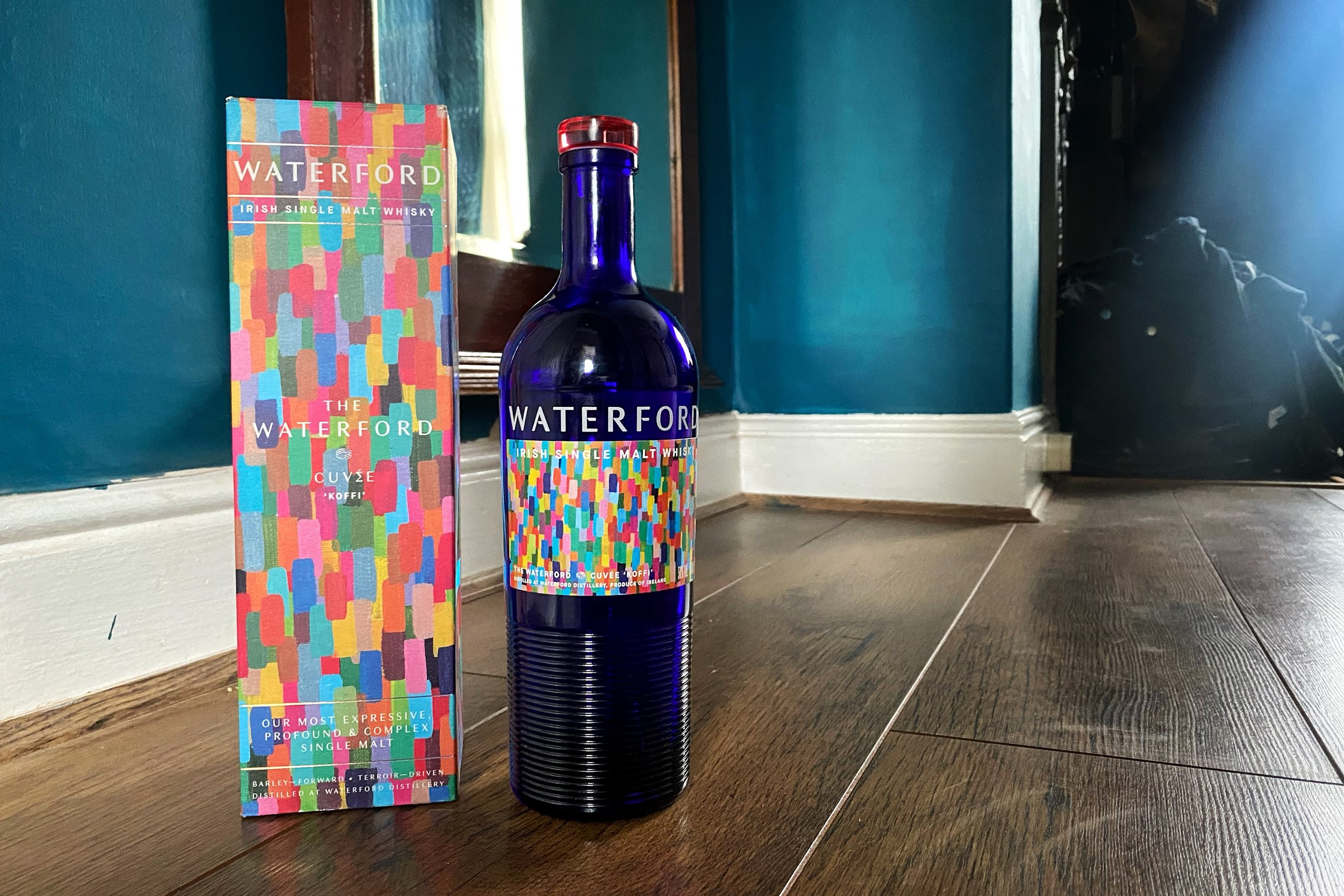Recently, I was kindly sent a bottle of Cuvée Koffi, a single malt whisky from Waterford Whisky, a distillery based in the Irish town of the same name.
I don’t write a lot about whisky, but it’s something I enjoy immensely, and would like to write about a bit more. I particularly enjoy American bourbon and rye, but love Islay and Speyside whiskies, as much as I do Irish whisky. Or whiskey, depending on whether the distillery in question uses the ‘e’. Waterford do not.
When it comes to Irish whisk(e)y, at the moment I am particularly fond of booth Teeling, and Redbreast 12. Both are what I would call ‘every day sippers’ because neither are particularly pricy, with the Redbreast 12 being slightly more expensive at just over £50 a bottle. But both are inherently mellow and smooth, with the Teeling showcasing delicate notes of citrus amid pockets of honeyed sweetness, while the Redbreast has a touch more sherried complexity: figs, dates, apricots, and marzipan. I want it to bake me a cake.
I’ve never tried a whisky from Waterford before, so I was excited to have the opportunity. I suspect this bottle arrived at my doorstep because Waterford are big into talking about terroir and using single farm origin barley varieties. Cuvée Koffi is reportedly their ultimate expression of this, bringing together single origin barley from no less than 24 farms, each harvest producing a standalone distillation before coming together as this whisky. A megablend of terroir, if you will.
You might know that I have argued about terroir before. It gets me in a bit of trouble when I do. It is my belief that terroir is a representation of everything that happens to ingredients before they are influenced by human intervention. I generally find that about 50% of people agree with me on this, and the other 50% argue that terroir is a direct result of human intervention. Perhaps I interpret the term too literally, but for me terroir is most definitely of the earth and not of the mash tun, or pot still.
Do I believe that barley can possess terroir? I think so. I have tasted beers made with varieties such as Chevallier, Golden Promise and Scotch Annat with remarkable differences. I have never explicitly tasted, say, Maris Otter grown in Cornwall against that grown in East Anglia. I would like to. I think it would be interesting to see if it made much difference. It probably does.
But do I believe that this can be showcased after mashing, fermentation and the precise art of distillation, where the distiller will select the best cut of distillate for the best flavour? There’s a more interesting word: flavour. That I can always believe in. The existence of Terroir should perhaps only be argued about by the gods, or maybe even with them, late into the night after polishing off a bottle of something delicious.
Terroir or not, Cuvée Koffi comes in a very pretty, very colourful bottle, its cardboard sleeve flecked with bright pinks, blues, yellows and greens. The bottle itself is rendered in a deep blue glass that is just as pleasing on the eye. I don’t like the glass stopper at all. It feels excessive and is a pain to get out (plus it doesn’t make the satisfying ‘plumpf’ of cork being removed from glass.)
This whisky is bottled at 50%, a hefty strength that gives it the musculature required to carry all of its reported terroir. And well-defined it is, with a sharp, strong, well cut nose that even the most burly of gym-bros would no doubt be proud of. It is a little on the hot side, which I found could be tamed with a dash of water, but also considered that this, or the addition of an ice cube did little to benefit or enhance its flavour, and that it was best enjoyed neat.
That flavour is where I consider that its strength and character becomes almost burdensome. When I sip aforementioned drams like Teeling or Redbreast, there’s a soft, almost sultry character, one you can really dig into but doesn’t interfere with what I believe is the primary purpose of drinking whisky: relaxation. Cuvée Koffi gives you no opportunity to rest. This is a bold, boisterous whisky, its grainy mouthfeel leaving behind cinder toffee, roasted hazelnut, and a deep, lingering hit of alcohol. It doesn’t let you take your attention away from it for a millisecond, which, in this case, I actually consider to be a flaw.
There is an awful lot going on here. Too much, in fact. Maybe it’s because at 6 years old it is quite young for such a powerfully flavoured whisky, and at 8, 10 or 12 years it might mellow to a point where it finds its level. Or maybe that’s the point? The label describes it as Waterford’s most “expressive, profound and complex single malt” and I would agree that it is all of those things. My question in response is: does it need to be?
